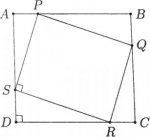I have a few questions on 6 questions I could not solve.
27. How many positive integers n less than 2015 have the property that \(\displaystyle \frac{1}{3}\, +\, \frac{1}{n}\) can be simplified to a fraction with a denominator less than n?
What have you tried? For instance, you started with the given sum, and simplified:
. . . . .\(\displaystyle \dfrac{1}{3}\, +\, \dfrac{1}{n}\, =\, \dfrac{n\, +\, 3}{3n}\)
For this to simplify to something with a denominator smaller than n, then we'll need to cancel something. For something to factor from n + 3, we must have a value of n which is a multiple of 3. Then n = 3k for some integer k. This gives us:
. . . . .\(\displaystyle \dfrac{3k\, +\, 3}{(3k)(3)}\, =\, \dfrac{k\, +\, 1}{3k}\)
What can you say about k and k + 1? What does this tell you about k + 1? And so forth.
28. A rectangle has all sides of integer length. When 3 units are added to the height and 2 units to the width, the area of the rectangle is tripled. What is the sum of the areas of all such rectangles?
What have you tried? For instance, you started with the basic geometry and algebra, which gave you the following:
. . . . .\(\displaystyle (h\, +\, 3)(w\, +\, 2)\, =\, 3hw\)
. . . . .\(\displaystyle hw\, +\, 3w\, +\, 2h\, +\, 6\, =\, 3hw\)
. . . . .\(\displaystyle 3w\, +\, 2h\, +\, 6\,=\, 2hw\)
. . . . .\(\displaystyle 6\, =\, 2hw\, -\, 3w\, -\, 2h\)
To make thiss factorable, we rearrange and add:
. . . . .\(\displaystyle 6\, +\, 3\, =\, 2hw\, -\, 2h\, -\, 3w\, +\, 3\)
. . . . .\(\displaystyle 9\, =\, 2h(w\, -\, 1)\, -\, 3(w\, -\, 1)\)
And so forth. Using the fact that the sides have integer lengths, where does this lead?
29. At Berracan station, northbound trains arrive every three minutes starting at noon and finishing at midnight, while southbound trains arrive every five minutes starting at noon and finishing at midnight. Each day, I walk to Berracan station at a random time in the afternoon and wait for the first train in either direction. On average, how many seconds should I expect to wait?
Stand in the station and start monitoring arrival times. What happens every fifteen minutes?
30. In a 14-by-18 rectangle ABCD, points P, Q, R, and S are chosen, on each side of ABCD as pictured.
View attachment 8169
The lengths AP, PB, BQ, QC, RD, DS, and SA are all positive integers and PQRS is a rectangle. What is the largest possible area that PQRS can have?
Have you tried anything with right triangles?





